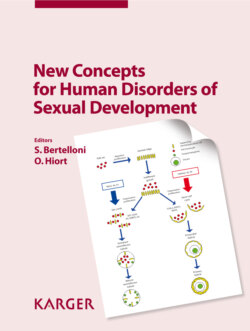Читать книгу New Concepts for Human Disorders of Sexual Development - Группа авторов - Страница 30
На сайте Литреса книга снята с продажи.
Testicular Descent
ОглавлениеFunction of the postpubertal testes is dependent on their scrotal position. The process of testicular descent consists of 2 phases: the first transabdominal phase of descent followed by the inguino-scrotal phase aiming to transfer the testes to a scrotal position. The first phase starts soon after testis determination and differentiation of Leydig cells and guides the testis from a position in the upper abdomen to the inner opening of the guinal channel in the pelvic part of the abdomen. After week 18 of gestation, the testes with the epididymis and the proximal part of vas deferens finally move through the inguinal canal. During the final 2 months of pregnancy before birth, the testes usually have a scrotal position.
Fig. 1. Histology of normal human testicular germ cells. Gonocytes, spermatogonia, spermatocytes, round and elongating spermatids are shown on the left side in cross sections of seminiferous tubules of a 1-year-old boy (a), a 5-year-old boy (b), a 12-year-old boy (c) and a 23-year-old man (d). Postnatal male germ cells of pre-meiotic, meiotic and post-meiotic phases during spermatogenesis are shown in detail in the bottom row (e). Abbreviations: gonocyte (G), spermatogonia (Spg); spermatocytes (Spc), round spermatids (rSpd), elongating and elongated spermatids (eSpd). Staining: haematoxylin/eosin (HE). Scale bar = 50 μm.
Fig. 2. Histology of testicular anomalies in humans. Fibrosis and Leydig cell hypoplasia are shown in cross sections of seminiferous tubules from an undescended testis of a 6-year-old boy (a, b), whereas only discrete fibrosis is shown in samples from an undescended testis of a 3-year-old boy (c, d). While all seminiferous tubules observed in the testis of the 6-year-old patient are lacking germ cells (b; white arrows), the seminiferous tubules of the 3-year-old patient still contain few spermatogonia and gonocytes (d; black arrows). A mixture of female and male gonadal cell types is shown in cross sections of an ovotestis of a newborn child (e, f). Primordial ovarian follicles (f; white arrowheads) are enclosed by an interstitial compartment remaining morphological features normally found in the testis. Abbreviations: blood vessels (bv), gonocyte (G), spermatogonia (Spg). Staining: haematoxylin/eosin (HE). Scale bar: a and c = 2 mm; e = 1 mm; b, d and f = 100 μm.
Approximately 3-4% of newborn boys suffer from uni- or bilateral undescended testes, which results in adverse effects on germ cell maturation (fig. 2a-d) [John Radcliffe Hospital Cryptorchidism Study Group, 1992; Berkowitz et al., 1993]. However, recent prospective data show large regional differences with figures as high as 9% in Denmark compared with 2.4% in Finland [Boisen et al., 2004]. Undescended testes can be grouped into 4 groups with respect to their location: (a) cryptorchidism: the testes are located proximal to the inguinal channel (intra-abdominally or retroperitoneally) and cannot be seen or palpated; (b) inguinal testes: testes are located within the inguinal channel and cannot be moved; (c) retractile testes: testes can be pushed into the scrotum but return back into the inguinal channel afterwards, and (d) testicular ectopy: the testes are located outside the normal route of descent, e.g. in the groin or femoral. In 75% of these cases, the testes descend within the first 3 months after birth [Berkowitz et al., 1993; Cortes et al., 2008]. However, 1% or more of the boys still have cryptorchid testes at the age of 12 months. These patients require treatment during early childhood to minimise the risk of infertility and of testicular germ cell tumour development later in life [Kollin et al., 2007]. During the last century, the influence of cryptorchidism on infertility, as well as on testicular cancer formation in adulthood, has been thoroughly investigated. Despite this fact, cryptor-chidism-related long-term effects are not well defined so far [Wood et al., 2009] because of limited access to testicular material from these patients. Many genes as FGFR1, WT1, AR, ARX, INSL3 or HOXA13, have been identified to be related to cryptorchidism (for details see online suppl. table 1) and high intra testicular testosterone is of importance for the 2nd phase of testicular descent.
Spermatogenesis requires an intact testicular environment with functional interactions between germ cells and somatic cells [for review see Sharpe, 1994; Wistuba et al., 2007]. In humans, these cellular interactions are established during the first months after birth, a process highly impaired in cryptorchid testes [Zivkovic et al., 2007]. Differentiation of gonocytes into type A spermatogonia within the first 6 months of postnatal life is essential for ongoing spermatogenic maturational processes and sperm production later in life and might be related to an increased testosterone production occurring during this time (‘mini-puberty’) [Forest et al., 1974; Hadziselimovic et al., 2001a, b; Zivkovic et al., 2007].
The formation and fate of spermatogonia from prepubertal boys suffering from cryptorchidism has been investigated in testicular biopsies in several studies [Ritzén et al., 2007; Wood et al., 2009]. There are indications that an increased testicular temperature might cause a disturbed formation of Adark spermatogonia which leads to infertility and/or testicular germ cell tumour development later in life [Hadziselimovic et al., 2001a, b]. However, it is still unclear if changes in germ cell proliferation and differentiation in cryptorchid testes are related to a disturbed somatic cell compartment or not.
